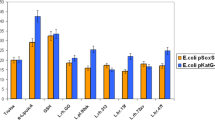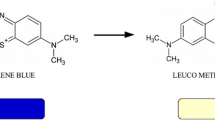Summary
The influence of 8 redox indicators with graded standard redox potentials between E′ 0=-340 mV and E′ 0=+115 mV was tested for the acidification by Streptococcus lactis in a liquid medium.
By redox indicators with standard redox potentials between-122 mV and +115 mV (Nile blue, methylene blue, brillant cresyl blue, and toluylene blue) the formation of lactic acid could be significantly increased, especially with low dye concentrations (4×10-5 and 10-4 m/l). Dyes with standard redox potentials between-289 mV and-122 mV (safranine T, phenosafranine, Janus green, Nile blue) on the other hand retarded the production of lactic acid by Strept. lactis in all or most of the dye concentrations used. Nile blue-representing the transition point between the two sections of redox indicators-increased the production of lactic acid very much in low concentrations and inhibited it as much in high concentrations.
The production of volatile acids was not increased by any dyestuff. It was delayed by dyes with standard redox potentials between-289 mV and +47 mV (safranine T, phenosafranine, Janus green, Nile blue, methylene blue, brillant cresyl blue). Janus green retarded the production of volatile acids in all analysed concentrations between 4×10-5 and 4×10-4 m/l. The greater the difference between the standard redox potential of the inhibiting dye and the standard redox potential of Janus green the smaller was the retarding effect in the lowest degree of concentration of 4×10-5 m/l. This stopping of the retarding effect was more effective towards standard redox potentials more negative then towards more positive ones.
The two dyes with the most extreme standard redox potentials (neutral red E′ 0=-340 mV, toluylene blue E′ 0=+115 mV) didn't obviously delay any acid formation, neither the production of lactic acid nor that of volatile acids. Of the two dyes only toluylene blue in the lowest concentration used (4×10-5 m/l) caused an increased production of lactic acid.
Zusammenfassung
Der Einfluß von acht Redoxindicatoren mit abgestuften Normalpotentialen zwischen E′ 0=-340 mV und E′ 0=+115 mV ist in einem Flüssigsubstrat auf die Säurebildung von Streptococcus lactis untersucht worden.
Durch Farbstoffe mit Normalpotentialen zwischen-122 mV und +115 mV (Nilblau, Methylenblau, Brillantkresylblau, Toluylenblau) konnte die Milchsäurebildung, besonders bei niederen Farbstoffkonzentrationen (4·10-5 und 10-4 m/l), signifikant gefördert werden. Farbstoffe mit Normalpotentialen zwischen-289 mV und-122 mV (Safranin T, Phenosafranin, Janusgrün, Nilblau) hemmten dagegen die Produktion von Milchsäure in allen oder in der Mehrzahl der angewendeten Konzentrationen. Niblau, das am übergang der beiden Potentialbereiche liegt, förderte die Milchsäurebildung sehr stark bei niederen und hemmte ebenso stark bei höheren Konzentrationen.
Die Bildung von flüchtigen Säuren wurde durch keinen der Farbstoffe gefördert. Eine Hemmung trat durch Farbstoffe mit Normalpotentialen zwischen-289 mV und +47 mV (Safranin T, Phenosafranin, Janusgrün, Nilblau, Methylenblau, Brillantkresylblau) ein. Janusgrün hemmte die Bildung flüchtiger Säuren in allen untersuchten Konzentrationen zwischen 4·10-5 und 4·10-4 m/l. Je weiter das Normalpotential des hemmenden Farbstoffes von dem Normalpotential des Janusgrüns abwich, desto geringer wurde die Hemmung in der geringsten Konzentrationsstufe von 4·10-5 m/l. Diese Unterbindung der Hemmwirkung wirkte sich in Richtung auf negativere Normalpotentiale mehr aus als in Richtung auf positivere Normalpotentiale.
Durch die beiden Farbstoffe mit den extremsten Normalpotentialen (Neutralrot E′ 0=-340 mV, Toluylenblau E′ 0=+115 mV) wurde weder die Produktion von Milchsäure noch die von flüchtigen Säuren merklich gehemmt. Eine Förderung der Milchsäurebildung konnte von beiden Farbstoffen nur durch Toluylenblan in der geringsten Konzentration (4×10-5 m/l) erzielt werden.
Similar content being viewed by others
Literatur
Barron, E. S. G., and Z. A. Hoffmann: Catalytic effect of dyes on oxygen consumption of living cells. J. gen. Physiol. 13, 483–494 (1930).
Baumberger, J. P.: The relation between the oxidation-reduction potential and the oxygen consumption role of yeast cell suspension. Cold. Spr. Harb. Symp. quant. Biol. 7, 195–215 (1939).
Beythien, A., u. W. Diemair: Laboratoriumsbuch für den Lebensmittelchemiker. Dresden-Leipzig: Th. Steinkopff 1963.
Boiteux, A.: Zur Wirkung von Malachitgrün auf die Atmung. Dissertation, Saarbrücken 1966.
Brooks, S. C., and M. M. Brooks: The permeability of living cells. Protoplasma Monogr. 19, Berlin: Bornträger 1941.
Clark, W. M.: Oxidation-reduction potentials of organic systems. Baltimore: 1960.
Cohen, B.: Reactions of oxidation-reduction indicators in biological material and their interpretation. Cold Spr. Harb. Symp. quant. Biol. 1, 214–223 (1933).
Dolin, M. J.: Oxidation and peroxidation of DPNH2 in extracts of Streptococcus faecalis. Arch. Biochem. 46, 483–485 (1953).
Eisenbrand, J., u. A. Klauck: Beeinflussung der Säureproduktion von Milchsäurebakterien durch Lebensmittelfarbstoffe. Z. Lebensmitteluntersuchung u.-forschung 108, 225–238 (1958).
—, u. E. Lang: Beemnussung der Säureproduktion von Milchsäurebakterien durch Azofarbstoffe. Z. Lebensmitteluntersuchung u.-forschung 113, 48–52 (1960).
—, u. H. O. Lohrscheid: Untersuchungen von Spaltprodukten, die bei der Milchsäuregärung aus Azofarbstoffen entstehen. I u. II. Arch. Pharm. (Weinheim) 292, 696–722 (1959a-b).
Ferguson, J.: The use of chemical potentials as indices of toxicity. Proc. roy. Soc. B 127, 387–404 (1939).
Genevois, L.: Coloration vitale et respiration. Protoplasma (Berl.) 4, 67–87 (1928).
Karlson, P.: Kurzes Lehrbuch der Biochemie. Stuttgart: G. Thieme 1966.
Koch, J., u. G. Bretthauer: Über eine zuverlässige Methode zur Bestimmung der Milchsäure in Süßmost und Wein. Z. analyt. Chem. 132, 346–356 (1951).
Leman, A.: Zur Frage der biogenen Reduktion von Neutralrot. Protoplasma (Wien) 64, 201–208 (1967).
Meeuse, B. J. D.: Flavin enzymes. Handbuch der Pflanzenphysiologie, Bd. XII/1, S. 214–262. Berlin-Göttingen-Heidelberg: Springer 1960.
Montag, A.: Beiträge zur enzymatischen und chemischen Bestimmung von Milchsäure und Äpfelsäure in Wein. Dissertation, Münster/Westf. 1960.
Pfankuch, E., u. G. Lindau: Zur Biochemie des Kartoffelabbaus. Biochem. Z. 277, 129–138 (1935).
Rabotnowa, J. L.: Die Bedeutung physikalisch-chemischer Faktoren (pH und rH2) für die Lebenstätigkeit der Mikroorganismen. Jena: VEB G. Fischer 1963.
Rummeni, G.: Über Redoxpotentiale und beschwerte Redoxsysteme in Gewebeaufschlämmungen der Kartoffelknolle. Ber. dtsch. bot. Ges. 71, 365–380 (1958).
—: Der katalytische Effekt von Redoxindikatoren bei der Messung physiologischer Redoxpotentiale in Gewebeaufschlämmungen der Kartoffelknolle. Ber. dtsch. bot. Ges. 72, 268–276 (1959).
Schaposchnikow, W. N.: Physiologie des Stoffwechsels von bakterien. Jena: VEB G. Fischer 1963.
Slater, E. C.: Oxidation-reduction potentials and their significance in hydrogen transfer. Handbuch der Pflanzenphysiologie, Bd. XII/1, S. 124–129. Berlin-Göttingen-Heidelberg: Springer 1960.
Smith, K. L.: Method for studying acid production and growth in lactic cultures. J. Dairy Sci. 48, 741–742 (1965).
Wartenberg, A., u. H.-L. Kläser: Die Temperaturabhängigkeit des Einflusses von Toluylenblau auf die Säurebildung von Streptococcus lactis. Arch. Mikrobiol. 64, 55–58 (1968).
Wartenberg, H.: Das physiologische Redoxpotential, ein Problem der Komplexchemie in der Biologie. Wiss. Z. der Friedrich Schiller-Universität Jena 8, 193–200 (1959).
Weber, E.: Grundriß der biologischen Statistik. Jena: VEB G. Fischer (1961).
Wieland, H., u. H. Sutter: Beiträge zur Wirkungsweise von Oxydasen und Peroxydasen. Ber. dtsch. chem. Ges., 63, 66–75 (1930).
Author information
Authors and Affiliations
Rights and permissions
About this article
Cite this article
Kläser, HL., Wartenberg, A. Der Einfluß von Redoxindicatoren auf die Säurebildung von Streptococcus lactis . Archiv. Mikrobiol. 64, 43–54 (1968). https://doi.org/10.1007/BF00412129
Received:
Issue Date:
DOI: https://doi.org/10.1007/BF00412129




